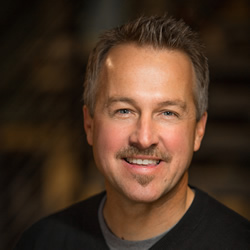Part of becoming a Level 5 multiplying church relies on changing the scorecard for your church and shifting what you count and celebrate. When your church starts to count and celebrate the number of other churches you plant or support, your scoreboard begins to reveal new measurements of success. In the article below, pastor and author Dave Ferguson shares how COMMUNITY has changed their scorecard to pursue a movement of multiplying churches.
A scoreboard never lies. At the end of nine innings of baseball, the scoreboard tells you which team won and which team lost. This fact is especially handy right now as we watch the Cubs and Dodgers and Blue Jays and Indians battle it out in the race for this year’s pennant! You may not always like what’s on the scoreboard, but a scoreboard tells the truth. It doesn’t tell the whole story, but it does tell you who won the game.
My scoreboard revealed that I was more interested in me and mine than God’s Kingdom.
What does the scoreboard for your church reveal? How do you know if you’re “winning” at God’s mission? Sometimes in our frantic hurry of ministry, we try to do the stuff that makes an impact. But one look at the scoreboard tells us we’re losing and falling farther behind.
A Movement of Multiplying Churches
When we first sat down as a group of friends from college and dreamed about what our church, COMMUNITY, could become, we scratched out the following three-phase dream on the back of a restaurant napkin:
Phase 1: Impact Church
Phase 2: Reproducing Church
Phase 3: Movement of Reproducing Churches
I remember a conversation a few years back with my friend Todd Wilson, who leads Exponential. He was looking at a recent blog post that included a graph showing more than 10,000 people in attendance at our church on an Easter weekend. Todd appropriately reminded me of my own dream—to see a movement of reproducing churches and not just one church with a big attendance number. I hadn’t intended to focus on growing only the church I was leading. But my scoreboard revealed that I was more interested in me and mine than God’s Kingdom.
Todd then pointed out that the number of people being reached through NewThing, our church-planting arm, was more than 50,000 people on the same Easter weekend. “Dave, measure what you say you value,” Todd told me, “because people will work toward what you measure.”
Later, I talked to Steve Addison, my Australian friend who understands movement making and what it takes to start a movement of multiplying churches. He told me, “Dave, movements are started by leaders who have died to their own success. This is not the thinking of the normal pastor or church planter.”
Leadership Residents and Your Family Tree of Multiplying Churches
These conversations were a turning point for COMMUNITY. We began to ask the question, “What does it take to catalyze a movement of reproducing churches?” We’re now asking, “What does it take to catalyze a movement of Level 5 multiplying churches? How do we start to see the number of multiplying churches in America go from less than one percent (where we are now) to a tipping point of 10 percent (where we want to be in 10 years)?
In 2012 we concluded that the following two measurements needed to be on our scoreboard if we were serious about multiplying churches:
Leadership residents – Leadership residents are church planters in training. A residency lasts from six to 12 months. This high-level apprenticeship is the key mechanism for movement making. To move us toward catalyzing a Level 5 multiplication movement, we challenge each of our campus pastors to have one leadership resident per year.
Family tree – The family tree is your church’s weekly attendance plus the weekly attendance of all the churches you’ve planted. Starting new churches requires sending leaders, people and resources. We wanted our scoreboard to reward and not penalize our campuses for sending money and people to start new campuses and new churches. So we came up with the metric called family tree. We discovered that an important measurement of multiplication is an increase by 15 percent in each family tree.
By measuring the family tree, our campus pastors worry less about losing leaders. They can willingly release resources to start new churches because they know it will be rewarded.
Movement Making: Define It.
If you’re ready to start measuring multiplication, you must first define what a movement of multiplication looks like. As challenging as defining a disciple and the mission of Jesus is, defining a movement is even tougher. I am still wrestling with how to define movement making, but the best definition I’ve seen comes from research by Ed Stetzer and Warren Bird. In their book, Viral Churches, they define a church-planting movement as, “A rapid multiplication of churches where a movement grows through multiplication by 50 percent in the number of churches in a given year to the third generation.”
That means, for example, if a church multiplies 100 times in one year, they should multiply at least 150 times the next year. Mostly new converts, not transfers, should account for that growth, and this kind of exponential growth continues to the third generation.
There have been years where NewThing has experienced that kind of rapid reproduction. Over a three-year span, we saw the number of new churches multiply from 32 to 64 to more than 100. Seventy percent of those new churches were started by leadership residents and huge numbers of new converts.
Use Stetzer’s and Bird’s definition or create your own. Ask the question, “What does it take to catalyze a movement of multiplying churches?” and then think about it, research it, pray over it and finally, define it.
Movement Making: Simplify It.
After answering the question, “What does it take to catalyze a movement of multiplying churches?” the next step is to simplify it. Take everything you’ve learned about church multiplication thus far and zero in on the qualities you believe are most important to becoming a multiplying church. Narrow it down to two or three qualities to keep it simple and memorable.
Movement Making: Measure It.
The last step is deciding how you’ll measure the few key essentials for movement making. Take those essentials that you have prioritized and determine the best way to measure each one of them. Because we’ve set leadership residents as a standard, it has become a key metric for multiplication.
Does counting leadership residents and the church attendance of your family tree ensure we will catalyze a movement of Level 5 multiplying churches? I have a strong conviction that it will, but only time will tell. However, I do know that when we keep score of things that spur multiplication, we have greater opportunity to see it happen!
So, go ahead and ask the question, “What does it take to catalyze a movement?” Answer the question in simple and measurable ways and add these new values to your scoreboard. If we want to see the mission of Jesus accomplished, it will come through a movement of multiplying churches.
Dave Ferguson is lead pastor of Community, which has grown from a few college friends to thousands every weekend meeting at multiple locations throughout Chicagoland. He also provides visionary leadership for NewThing and is the author/co-author of Exponential (with Jon Ferguson), On the Verge (with Alan Hirsch), Discover Your Mission Now!, Finding Your Way Back to God and Starting Over, and the Exponential eBook, Keeping Score: How to Know If Your Church Is Winning. Download a free copy of Keeping Score here.
Changing your church’s scorecard starts with understanding where you are and where you want to be. Visit church-multiplication.com to take Exponential’s Becoming 5 self-assessment and evaluate your current multiplication level as well as the level you aspire to reach.







